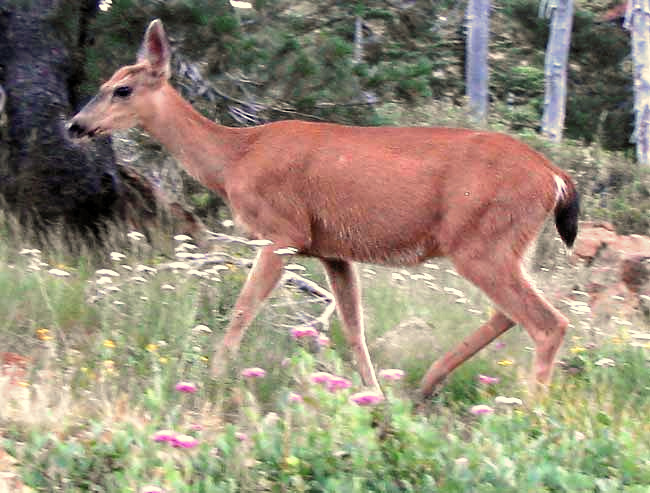Excerpts from Jim Conrad's
Naturalist Newsletter

from the July 26, 2009 Newsletter, describing a backpacking trip on the Pacific Crest National Scenic Trail in Red Buttes Wilderness Area, Siskiyou County, California:
A NOSEY BLACK-TAILED DEER
As the sun sank I staked my tent on Kangaroo Spring's meadow. Just as I began dozing off the sound of a herbivore clipping herbage arose right outside the tent. My tent's walls are composed of see-through netting so it was easy enough even in the dim light to see standing ten feet away a Columbian Black-tailed Deer, ODOCOILEUS HEMIONUS ssp. COLUMBIANUS, looking straight at me.
The deer leaped backward but ran only a few feet away, turned around, looked at me, then returned to his earlier spot and began munching again. This happened several times. The deer walked all around the tent, enabling me to take the dimly-lit picture shown above.
The critter took a poop not twenty feet away, so I can report that for the deer shown in the picture pooping is done dog-like, spreading the back legs and dropping the rear end halfway down, and looking around nonchalantly, almost debonairly.
How do Black-tailed Deer differ from White-tailed Deer?
Black-tailed Deer carry their black-tipped tails drooped while White-tails, at least in flight, keep their white tails uplifted. Black-tailed Deer are a kind of mule deer so they run with a series of stiff-legged jumps during which all four feet come off the ground together, while the White-tail runs more like a horse. Black-tails have larger ears, while White-tails have larger tails. Black-tail antlers normally are smaller than those of White-tails, typically branching to form only two equal forks, while White-tails antlers are forward-curving and may bear several points, or tines, branching from the main beam.